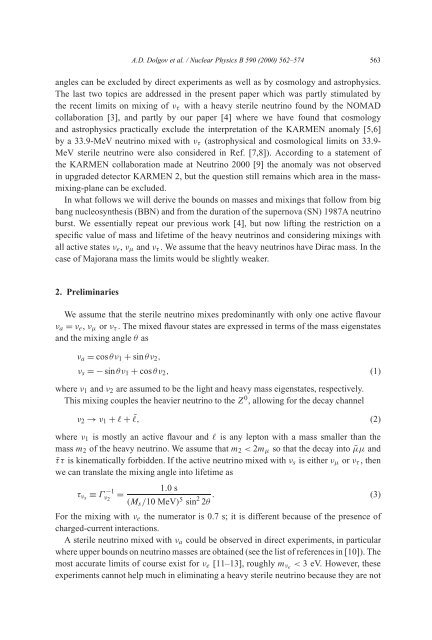Heavy sterile neutrinos - MPP Theory Group
Heavy sterile neutrinos - MPP Theory Group
Heavy sterile neutrinos - MPP Theory Group
Create successful ePaper yourself
Turn your PDF publications into a flip-book with our unique Google optimized e-Paper software.
A.D. Dolgov et al. / Nuclear Physics B 590 (2000) 562–574 563<br />
angles can be excluded by direct experiments as well as by cosmology and astrophysics.<br />
The last two topics are addressed in the present paper which was partly stimulated by<br />
the recent limits on mixing of ν τ with a heavy <strong>sterile</strong> neutrino found by the NOMAD<br />
collaboration [3], and partly by our paper [4] where we have found that cosmology<br />
and astrophysics practically exclude the interpretation of the KARMEN anomaly [5,6]<br />
by a 33.9-MeV neutrino mixed with ν τ (astrophysical and cosmological limits on 33.9-<br />
MeV <strong>sterile</strong> neutrino were also considered in Ref. [7,8]). According to a statement of<br />
the KARMEN collaboration made at Neutrino 2000 [9] the anomaly was not observed<br />
in upgraded detector KARMEN 2, but the question still remains which area in the massmixing-plane<br />
can be excluded.<br />
In what follows we will derive the bounds on masses and mixings that follow from big<br />
bang nucleosynthesis (BBN) and from the duration of the supernova (SN) 1987A neutrino<br />
burst. We essentially repeat our previous work [4], but now lifting the restriction on a<br />
specific value of mass and lifetime of the heavy <strong>neutrinos</strong> and considering mixings with<br />
all active states ν e , ν µ and ν τ . We assume that the heavy <strong>neutrinos</strong> have Dirac mass. In the<br />
case of Majorana mass the limits would be slightly weaker.<br />
2. Preliminaries<br />
We assume that the <strong>sterile</strong> neutrino mixes predominantly with only one active flavour<br />
ν a = ν e , ν µ or ν τ . The mixed flavour states are expressed in terms of the mass eigenstates<br />
and the mixing angle θ as<br />
ν a = cos θν 1 + sin θν 2 ,<br />
ν s =−sin θν 1 + cos θν 2 , (1)<br />
where ν 1 and ν 2 are assumed to be the light and heavy mass eigenstates, respectively.<br />
This mixing couples the heavier neutrino to the Z 0 , allowing for the decay channel<br />
ν 2 → ν 1 + l + ¯l, (2)<br />
where ν 1 is mostly an active flavour and l is any lepton with a mass smaller than the<br />
mass m 2 of the heavy neutrino. We assume that m 2 < 2m µ so that the decay into ¯µµ and<br />
¯ττ is kinematically forbidden. If the active neutrino mixed with ν s is either ν µ or ν τ ,then<br />
we can translate the mixing angle into lifetime as<br />
τ νs ≡ Γν −1<br />
1.0s<br />
2<br />
=<br />
(M s /10 MeV) 5 sin 2 2θ . (3)<br />
For the mixing with ν e the numerator is 0.7 s; it is different because of the presence of<br />
charged-current interactions.<br />
A <strong>sterile</strong> neutrino mixed with ν a could be observed in direct experiments, in particular<br />
where upper bounds on neutrino masses are obtained (see the list of references in [10]). The<br />
most accurate limits of course exist for ν e [11–13], roughly m νe < 3 eV. However, these<br />
experiments cannot help much in eliminating a heavy <strong>sterile</strong> neutrino because they are not













